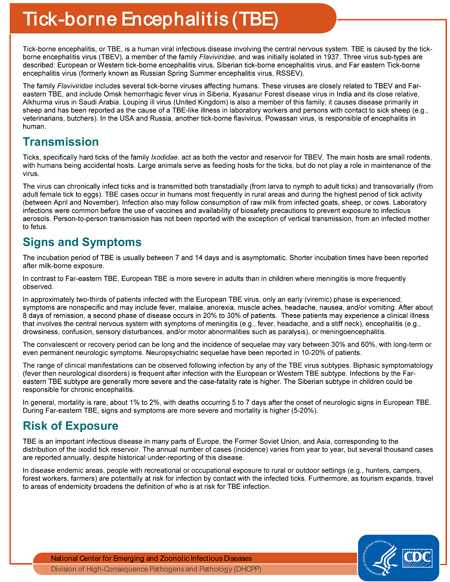Resources
References
- Davidson MM, Williams H, Macleod JA. Louping ill in man: a forgotten disease. Journal of Infection. 1991;23(3):241-49.
- Ebel GD. Update on Powassan virus: emergence of North American tick-borne flavivirus. Annual Review of Entomology. 2010;55:95-110
- Grard G, Moureau G, Charrel RN, et al. Genetic characterization of tick-borne flaviviruses: New insights into evolution, pathogenetic determinants and taxonomy. Virology. 2007;361:80-92.
- Kaiser R. Tick-borne encephalitis. Infectious Disease Clinics of North America. 2008;22(3):561-75.
- Kaiser R, Holzmann H. Laboratory findings in tick-borne encephalitis: Correlation with clinical outcome. Infection. 2000;28(2):78-84.
- Lesnicar G, Poljak M, Seme K, et al. Pediatric tick-borne encephalitis in 371 cases from an endemic region in Slovenia, 1959 to 2000. Pediatric Infectious Disease Journal. 2003;22(7):612-17.
- Lindquist L, Vapalahti O. Tick-borne encephalitis. Lancet. 2008;371(9627):1861-71.
- Logar M, Arnez M, Kolbl J, et al. Comparison of the epidemiological and clinical features of tick-borne encephalitis in children and adults. Infection. 2000;28 (2):74-7.
- Rendi-Wagner P. Advances in vaccination against tick-borne encephalitis. Expert Review of Vaccines. 2008;7(5):589-96.
- Suess J. Tick-borne encephalitis in Europe and beyond — the epidemiological situation as of 2007. Euro Surveillance. 2008;13(26).
- Zent O, Broker M. Tick-borne encephalitis vaccines: past and present. Expert Reviews Vaccines. 2005;4(5):747-55.
- Page last reviewed: March 31, 2014
- Page last updated: March 31, 2014
- Content source:


 ShareCompartir
ShareCompartir
